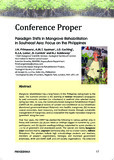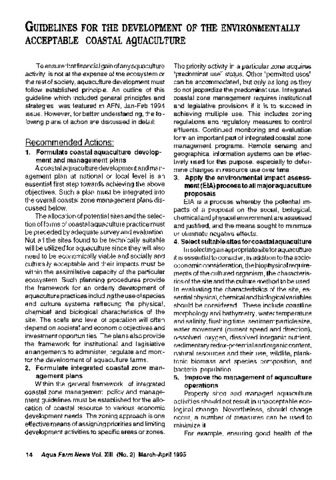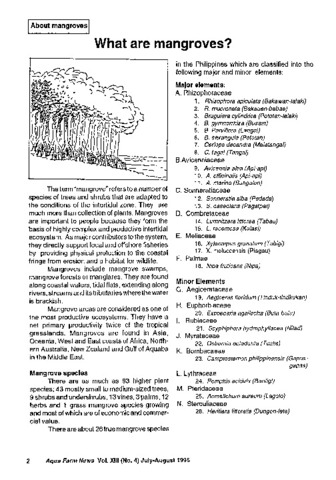| dc.contributor.author | Primavera, Jurgenne H. | |
| dc.contributor.editor | Davies, Jon | |
| dc.contributor.editor | Claridge, Gordon | |
| dc.date.accessioned | 2011-06-22T09:35:25Z | |
| dc.date.available | 2011-06-22T09:35:25Z | |
| dc.date.issued | 1992 | |
| dc.identifier.citation | Primavera, J. H. (1992). Mangrove conversion and brackishwater pond culture in the Philippines. In J. Davies & G. Claridge (Eds.), Protection and Sustainable Use of Wetland Resources in the Philippines. Proceedings of a Workshop, 30 September to 2 October 1992, Institute of Forest Conservation, University of the Philippines at Los Baños, Los Baños, Laguna, Philippines (pp. 77-90). Kuala Lumpur, Malaysia: Asian Wetland Bureau; Manila, Philippines: Protected Areas and Wildlife Bureau. | en |
| dc.identifier.uri | http://hdl.handle.net/10862/353 | |
| dc.description.abstract | Around 50% of mangrove loss in the Philippines can be traced to brackishwater pond construction. The decrease in mangroves from 450 000 ha in 1920 to 132 500 ha in 1990 has been accompanied by expansion of culture ponds to 223 000 ha in 1990. The history of fishpond development in the country includes a government-sponsored fishpond boom in the 1950-g and 1960s, the proconservation decade of the 1970s followed by a shrimp fever in the 1980s. Production from brackishwater ponds has increased from 15 900 mt worth P7.6 million in 1938 to 267 000 mt valued at P6.5 billion in 1990. On the other hand, the maximum valuation of over $11000 ha−1 yr−1 for unmanaged and managed mangrove forests makes them economically on par with the most profitable pond farming systems. The loss of mangrove systems and their varied goods and services is the single most important consequence of brackishwater pond culture in the Philippines. Moreover, intensive shrimp farming is associated with other ecological and socioeconomic effects such as pollution of coastal waters and decline in domestic food crops. New legislation and enforcement of existing laws, conservation of remaining mangroves, massive rehabilitation of denuded mangrove areas, and promotion of sustainable aquaculture and fisheries are recommended. | en |
| dc.language.iso | en | en |
| dc.publisher | Asian Wetland Bureau | en |
| dc.publisher | Protected Areas and Wildlife Bureau | en |
| dc.relation.ispartof | In: Davies, J., Claridge, G. (eds.). Protection and Sustainable Use of Wetland Resources in the Philippines. Proceedings of a Workshop, 30 September - 02 October 1992, Institute of Forest Conservation, University of the Philippines at Los Baños, Los Baños, Laguna, Philippines. Kuala Lumpur, Malaysia: Asian Wetland Bureau; Quezon City, Philippines: Department of Environment and Natural Resources. AWB Publication No. 82a. pp. 77-90 | en |
| dc.subject | Philippines | en |
| dc.subject.lcc | VF SP 145 | |
| dc.title | Mangrove conversion and brackishwater pond culture in the Philippines | en |
| dc.type | Conference paper | en |
| dc.citation.spage | 77 | |
| dc.citation.epage | 90 | |
| dc.subject.asfa | mangroves | en |
| dc.subject.asfa | policies | en |
| dc.subject.asfa | aquaculture development | en |
| dc.subject.asfa | mangrove swamps | en |
| dc.subject.asfa | nature conservation | en |
| dc.subject.asfa | environmental impact | en |
| dc.subject.asfa | Man-induced effects | en |
| dc.subject.asfa | coastal zone management | en |
| dc.subject.asfa | economics | en |
| dc.subject.asfa | Conservation | en |
| dc.citation.conferenceTitle | Protection and Sustainable Use of Wetland Resources in the Philippines. Proceedings of a Workshop, 30 September to 2 October 1992, Institute of Forest Conservation, University of the Philippines at Los Baños, Los Baños, Laguna, Philippines | en |



